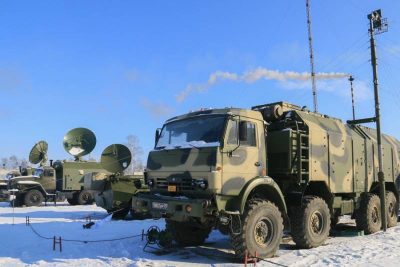Russia’s Military Undertaking Growing Role in Creation of ‘Sovereign Internet’
Publication: Eurasia Daily Monitor
By: Roger McDermott
The Jamestown Foundation

Russia’s Ministry of Defense has confirmed its involvement in the creation of a “sovereign Internet,” which marks part of its wider efforts to transform its system of military communications. This will involve the Russian military in the development of the Multiservice Transport Communication Network (Multiservisnaya Transportnaya Set Svyazi—MTSS). As a result, the military will extend fiber optic cable along the Arctic coast. The system will instantly transfer any volume of information, from Kaliningrad to Vladivostok, and is also aimed to help develop the national economy. It will be isolated from the broader World Wide Web, but connected to the Russian segment of the Internet (websites with the top-level domain ending in .ru), also known as the Runet (Voyenno Promyshlennyy Kuryer, April 2).
Russian legislators are currently formulating the necessary legal basis to create a Runet capable of standing alone. These relate to amendments to existing laws on communication and information. The bulk of the legal framework is tied up in the draft Law on Sustainable Work of the Runet, which has passed its first reading in the State Duma (lower chamber of parliament). The law aims to ensure the continuous functioning of the Runet, taking into account a variety of information-based threats from abroad. However, the involvement of the Russian military in the project is also important for the future of military communications, although many aspects remain hidden from public view (Army-news.ru, March 13).
The Russian military, of course has its own closed intranet, secured from the global Internet and designed to avoid penetration. Indeed, in 2016, the military launched a version of its intranet known as the “Closed Data Transfer System” (Zakrytyy Segment Peredachi Dannykh—ZSPD). The ZSPD serves to secure information transfers in a closed and secure information environment; it can only be accessed using computers operating under a special server and allows connection through specially protected flash drives. The ZSPD offers military e-mail, and also full-fledged websites and links. During the next two years, the system of military communications will be fully modernized. In essence, the military is accessing civilian science to build a modernized communications network capable of handling and transferring large amounts of data, including voice and video. The ZSPD, however, in order to remain secure, will not intersect with the Runet or the Internet in general (Voyenno Promyshlennyy Kuryer, April 2).
This will necessitate a major overhaul of the existing system of military command, control and communications. The afore-mentioned MTSS will resolve issues of transmitting and processing information in a secure environment and replace large-scale networks and systems currently in use. The first public information on the military role in the sovereign network project emerged in Krasnaya Zvezda, on March 1. The article was authored by Captain 1st Rank Alexander Pisarenko, the chief of the Directorate-General for Communications of the Russian Armed Forces. In his piece, he examines the challenges of modernizing military communications and building a fundamentally new network. Pisarenko argues that the MTSS can be exploited by the military to create networks at zonal and trunk levels to transmit vast quantities of data, applying new information management solutions. In his view, the MTSS will consist of several interconnected components: these are the subsystems of organizational, operational-technical and technological management. The MTSS will also provide a data storage system. All the elements of the MTSS will operate in a single information security loop. One of the key technological advances is the ability of the system to automatically detect and respond to external threats (Army-news.ru, March 13).
Returning to the legal basis for creating a national system of routing Internet traffic, the proposed Duma legislation (see above) suggests a wider effort to respond to developments in the United States. In particular, the explanatory note to the first reading of the draft law notes the “aggressive nature” of the US National Cyber Security Strategy, adopted in September 2018. The draft law reportedly offers a set of arguments in favor of creating an autonomous network. It seeks to minimize the possible transfer of data abroad originating from communications between Russian users, as well as to protect the network from criminality, accidents or a deliberate cyberattack on the Russian State (Voyenno Promyshlennyy Kuryer, April 2).
When the Law on Sustainable Work of the Runet is finally passed, the telecommunications watchdog Roskomnadzor will receive enormous powers and benefits. It will be able to block legally prohibited sites and oversee the autonomous functioning of the Runet (Voyenno Promyshlennyy Kuryer, April 2). While the Runet project presents enormous challenges, its general aim is clearly to strengthen the ability of the state and economy to withstand cyberattacks. The known extent of military involvement in the project remains incomplete, but it appears that the Armed Forces aim, as a complimentary element in this process, to not only benefit but use this as an opportunity to transform military communications.
Russia’s military involvement in this national-scale project will primarily link to the MTSS. Although little precise detail in known about the defense ministry involvement in this latest effort to enhance military communications in a secure information environment, it seems to complement other efforts to revolutionize the technological components in the military system. Though the Armed Forces already have secure servers and a secure intranet, they are evidently interested in further improvements to exploit modern technologies aimed at boosting the quality and security of the overall system. The MTSS, therefore, fits the drive to adopt Command, Control, Communications, Computers, Intelligence, Surveillance and Reconnaissance (C4ISR) technologies and capabilities, as well as strengthen the cyber security of the Armed Forces.
The Jamestown Foundation kindly allows Modern Tokyo Times to publish their highly esteemed articles. Please follow and check The Jamestown Foundation website at http://www.jamestown.org
https://twitter.com/JamestownTweets The Jamestown Foundation
Photo source: Image in the original article by The Jamestown Foundation from Weaponnews.com